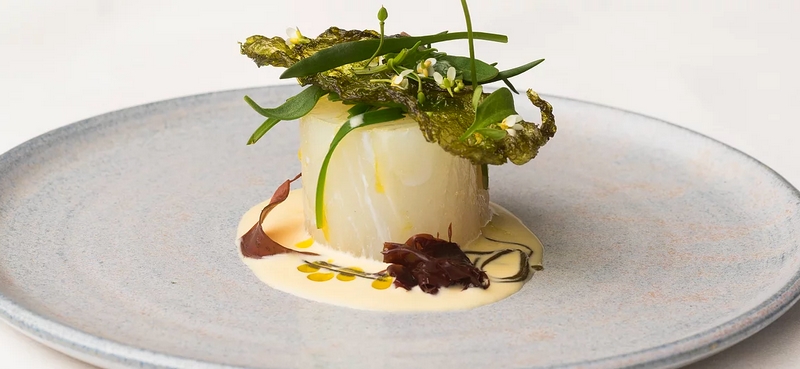
Mews Restaurant is a Michelin Star restaurant in Baltimore Village, at the South-West tip of Ireland. Mews was founded on the principle of exploring Irish cuisine through the extraordinary ingredients of the region of West Cork. photo: mewsrestaurant.ie/
County Cork in Ireland, the home of Roy Keane and rugged coastlines, has a new claim to fame: it’s now a gastronomic hotspot.
The 2019 Michelin guide for Great Britain and Ireland includes three Cork restaurants in a list of new entries published this week.
Ichigo Ichie in Cork city, Mews in the village of Baltimore, and Chestnut in the hamlet of Ballydehob won the honours at a ceremony in London that recognised their chefs’ talents and the region’s bountiful produce.
There is, however, an additional ingredient in Cork’s culinary triumph: hippies. West Cork was part of the hippy trail which drew artists and wanderers from around the world in the 60s and 70s. Some stayed and learned to farm, fish and cook, kickstarting a gourmet revolution.
“They were into natural ingredients, self-sustaining lifestyles and and organic agriculture before it was ever a term,” said Robert Collender, the co-owner of Mews, a seasonal restaurant which uses only local produce. The head chef, Ahmet Dede, is from Turkey.
The tasting menu at Mews includes Sherkin Island oyster, wakame and wood sorrel, plus smoked mackerel, kombu, parsley and wild fennel.
A legacy of traditional farming methods and artisanal food production made Cork a mecca for “second generation” culinary innovators, said Collender, 35, who moved here from Dublin. “We were after a place where we had everything on our doorstep.”
Local chefs, successors to the earlier influx who learned to harvest one of the world’s great natural larders, climb cliffs, wade into the sea and kayak to forage for herbs, seaweed and other edible ingredients, said Helen Collins, chair of A Taste of West Cork, an annual food festival.
“They wouldn’t call themselves hippies. I’d call them creative people because out of that whole creative movement in the 70s we had this incredible abundance.”
The first pioneers learned to make specialty cheese, smoke fish and experiment with lamb, beef and vegetables … a clean environment and fresh raw materials made Cork, especially west Cork, a culinary haven, said Collins. “We have known this all our lives. It’s just that the rest of the world hadn’t caught up with it.”
Rob Krawczyk, 41, the chef who owns and runs Chestnut, grew up in Cork and learned about food from his father, an immigrant from Britain with Polish heritage who is a master of charcuterie. “My dad does a lot of sourcing for me. The produce is just second to none,” he said.
Chestnut’s starters include brill with cauliflower, ink and parsley. Dessert is brambles with yogurt and clove sorbet or strawberries, lovage and goat’s cheese.

There was nothing wrong with Ireland’s traditional staples – potatoes, bacon and cabbage – but Ireland’s food culture was evolving, said Krawczyk. “We’re building a food identity for ourselves in the last 10 years.”
Chestnut, built on the site of a former pub with a slanted roof, has only six tables. It closes in January and February. Ballydehob, the surrounding hamlet, has a population of 270. Winning a Michelin star has rocketed the restaurant’s profile, said Krawczyk. “It’ll sustain us through the winter, which is fantastic.”
Cork’s culinary fame bloomed in the 70s. Three restaurants won Michelin stars and chefs such as Myrtle Allen acquired devoted followers.
“There’s always been this rich scene of food provenance and innovative chefs,” said Kate Ryan, a west Cork-based food writer. “That first generation showed that you can live on what feels like the edge of the planet and create a thriving food business.”
Dublin then eclipsed Cork as a foodie destination and the rebel county ebbed as a culinary force until a new influx of chefs and restaurateurs, Irish and foreign, who learned their craft around the world, said Ryan.
“The Michelin news is fantastic. The ripple effect is going to be just huge. It’ll be great not just for those particular chefs and their teams but other chefs and restaurateurs in the region.”
Standing by his chopping table in Ichigo Ichie, in Cork city, Takashi Miyazaki said he travelled around Ireland a decade ago seeking a location to set up a restaurant and chose Cork because of the freshness and variety of ingredients and because it reminded him of Fukuoka, his coastal home in Japan.
Irish people told him they loved Japanese food but were eating “plastic sushi”, deepening his resolve to create proper Japanese cuisine, he said.
Ichigo Ichie, which translates as “once in a lifetime”, opened five months ago. It seats 25 diners in a dimly lit, spartan setting. It is fully booked until January. The Michelin star has delighted his suppliers. “You’re a legend, boy!” one exulted.
The restaurant offers a no-choice kaiseski, a tasting menu of 12 courses, for €95. Dishes include nankin tsuki usagi – pumpkin, pumpkin seeds, satsuma autumn mikan and sweet potato, and kamo nanban soba – Thornhill duck, buckwheat, negi, hay leek and soba.
Miyazaki, 43, met Stephanie, his Irish future wife, while cooking bangers and mash at a Molly Malone’s Irish bar in Hiroshima, Japan. They opted for Cork instead of Dublin, Galway and Belfast. “It suits me – it’s just a feeling,” he said. Expressing a kinship with the culinary pioneers who settled in west Cork in the 70s, Miyazaki added: “There are still so many hippies there.”
guardian.co.uk © Guardian News & Media Limited 2010
Published via the Guardian News Feed plugin for WordPress.

